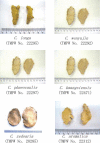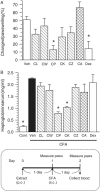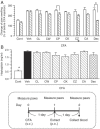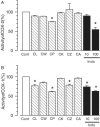Comparison of Anti-inflammatory Activities of Six Curcuma Rhizomes: A Possible Curcuminoid-independent Pathway Mediated by Curcuma phaeocaulis Extract
- PMID: 16786056
- PMCID: PMC1475933
- DOI: 10.1093/ecam/nel008
Comparison of Anti-inflammatory Activities of Six Curcuma Rhizomes: A Possible Curcuminoid-independent Pathway Mediated by Curcuma phaeocaulis Extract
Abstract
We aimed to compare the anti-inflammatory activities of six species of Curcuma drugs using adjuvant arthritis model mice. When orally administered 1 day before the injection of adjuvant, the methanol extract of Curcuma phaeocaulis significantly inhibited paw swelling and the serum haptoglobin concentration in adjuvant arthritis mice. Also when orally administered 1 day after the injection of adjuvant, the methanol extract of Curcuma phaeocaulis significantly inhibited paw swelling. Other Curcuma species (Curcuma longa, Curcuma wenyujin, Curcuma kwangsiensis, Curcuma zedoaria and Curcuma aromatica) had no significant inhibitory effects on adjuvant-induced paw swelling. Cyclooxygenase (COX)-2 activity was significantly inhibited by the methanol extract of C. phaeocaulis. Curcuminoids' (curcumin, bis-demethoxycurcumin and demethoxycurcumin) were rich in C. longa, but less in C. phaeocaulis and C. aromatica, not in C. wenyujin, C. kwangsiensis and C. zedoaria, suggesting that curcuminoids' contents do not relate to inhibition of arthritis swelling. Therefore, C. phaeocaulis may be a useful drug among Curcuma species for acute inflammation, and the active constituents of C. phaeocaulis are not curcuminoids.
Figures




Similar articles
-
Simplex lattice design for optimization of the mass ratio of Curcuma longa L., Curcuma zedoaria (Christm.) Roscoe and Curcuma aromatica Salisb. to maximize curcuminoids content and antioxidant activity.Acta Pharm. 2020 Dec 31;71(3):445-457. doi: 10.2478/acph-2021-0025. Print 2021 Sep 1. Acta Pharm. 2020. PMID: 36654094
-
Variation on Composition and Bioactivity of Essential Oils of Four Common Curcuma Herbs.Chem Biodivers. 2017 Nov;14(11). doi: 10.1002/cbdv.201700280. Epub 2017 Nov 23. Chem Biodivers. 2017. PMID: 28795782
-
Sequence analysis of Chinese and Japanese Curcuma drugs on the 18S rRNA gene and trnK gene and the application of amplification-refractory mutation system analysis for their authentication.Biol Pharm Bull. 2002 Dec;25(12):1593-9. doi: 10.1248/bpb.25.1593. Biol Pharm Bull. 2002. PMID: 12499646
-
Ethnobotany, Phytochemistry and Traditional Uses of Curcuma spp. and Pharmacological Profile of Two Important Species (C. longa and C. zedoaria): A Review.Curr Pharm Des. 2019;25(8):871-935. doi: 10.2174/1381612825666190402163940. Curr Pharm Des. 2019. PMID: 30947655 Review.
-
Curcuminoids: Implication for inflammation and oxidative stress in cardiovascular diseases.Phytother Res. 2019 May;33(5):1302-1317. doi: 10.1002/ptr.6324. Epub 2019 Mar 4. Phytother Res. 2019. PMID: 30834628 Review.
Cited by
-
Anti-Inflammatory Activities of Cinnamomum cassia Constituents In Vitro and In Vivo.Evid Based Complement Alternat Med. 2012;2012:429320. doi: 10.1155/2012/429320. Epub 2012 Mar 27. Evid Based Complement Alternat Med. 2012. PMID: 22536283 Free PMC article.
-
Anti-Inflammatory and Antioxidant Chinese Herbal Medicines: Links between Traditional Characters and the Skin Lipoperoxidation "Western" Model.Antioxidants (Basel). 2022 Mar 23;11(4):611. doi: 10.3390/antiox11040611. Antioxidants (Basel). 2022. PMID: 35453296 Free PMC article. Review.
-
Involvement of Heme Oxygenase-1 Participates in Anti-Inflammatory and Analgesic Effects of Aqueous Extract of Hibiscus taiwanensis.Evid Based Complement Alternat Med. 2012;2012:132859. doi: 10.1155/2012/132859. Epub 2012 Jun 21. Evid Based Complement Alternat Med. 2012. PMID: 22778769 Free PMC article.
-
Predicting cyclooxygenase inhibition by three-dimensional pharmacophoric profiling. Part II: Identification of enzyme inhibitors from Prasaplai, a Thai traditional medicine.Phytomedicine. 2011 Jan 15;18(2-3):119-33. doi: 10.1016/j.phymed.2010.08.002. Epub 2010 Sep 20. Phytomedicine. 2011. PMID: 20851587 Free PMC article.
-
(+)/(-)-Phaeocaulin A-D, four pairs of new enantiomeric germacrane-type sesquiterpenes from Curcuma phaeocaulis as natural nitric oxide inhibitors.Sci Rep. 2017 Mar 8;7:43576. doi: 10.1038/srep43576. Sci Rep. 2017. PMID: 28272397 Free PMC article.
References
-
- Ozaki Y. Antiinflammatory effect of Curcuma xanthorrhiza Roxb., and its active principles. Chem Pharm Bull. 1990;38:1045–8. - PubMed
-
- Gonda R, Tomoda M, Ohara N, Takada K. Arabinogalactan core structure and immunological activities of ukonan C, an acidic polysaccharide from the rhizome of Curcuma longa. Biol Pharm Bull. 1993;16:235–8. - PubMed
-
- Li SZ. ‘Ben-cao gang-mu’. In: Jiangxi , editor. House, Beijing: The People's Health Pub.; 1977. pp. 880–5.
-
- Sreejayan N, Rao MN. Free radical scavenging activity of curcuminoids. Arzneimittelforschung. 1996;46:169–71. - PubMed
LinkOut - more resources
Full Text Sources
Other Literature Sources
Research Materials
Miscellaneous

